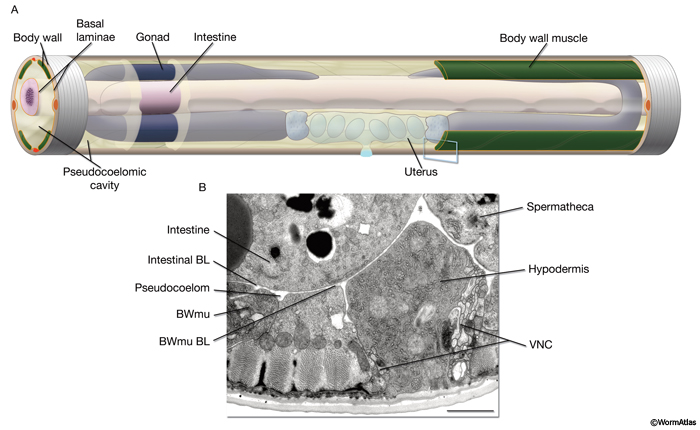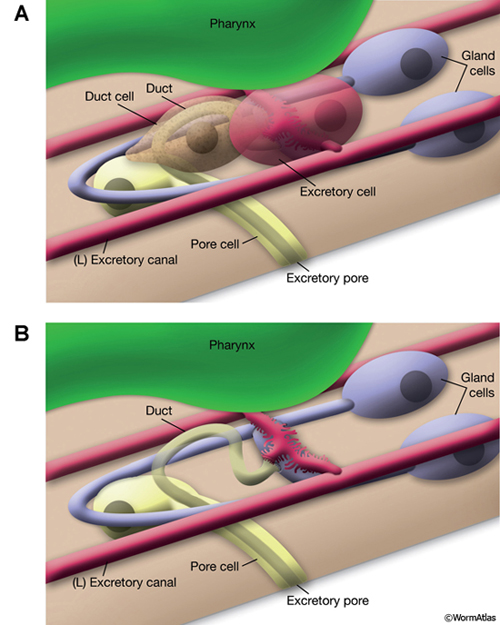Team:Queens-Canada/pseudocoelom
From 2010.igem.org
The Pseudocoelom and the Excretory System
Like humans, the organs of C. elegans aren't simply pressed against one another with no gaps in between. Internal organs need access to nutrients, a means to eliminate metabolic waste, and inter-tissue communication. This system, referred to as the pericellular system by WormAtlas, is roughly equivalent to the circulatory and renal systems in humans.

From WormAtlas
The Pseudocoelom
The pseudocoelom is a fluid-filled body which bathes all tissues. It is directly analogous to blood vessels in higher animals; however, it is not circulated, nor fully lined with specialized cells. Its major responsibility is providing cells with the oxygen, ions and nutrients that they require in order to function. It also acts as a conduit for intercellular signalling, and may potentially have great value to synthetic biology as a medium for sending messages to different parts of the worm without disrupting preexisting mechanisms.
Signalling in the pseudocoelom is typically accomplished through hormones, molecules that many multicellular organisms use to send messages via their circulatory systems. The majority of hormones are either peptide-based (in which case they are derived directly from a gene product, possibly with post-translational modification) or steroid hormones (in which case they are created by modifications to the molecule cholesterol.)
More on hormones and neuropeptides
Steroid hormones offer a particular convenience in that, since they are largely non-polar, they pass through lipid bilayers easily and may not require a receptor outside of the nucleus itself, which binds directly to DNA and is affected by the presence of its effector hormone. However, engineering the pathway necessary to design and introduce a new steroid hormone that would be non-toxic and fully distinguishable to the organism would be greatly time-consuming. Instead, it may be more practical to design new peptide hormones, or to take them from other sources. They can be received via GPCRs at the surface, and more conventional signalling pathways can be utilized intracellularly to activate or deactivate the genes in question. Some peptide hormones are released directly by neurons, and also used as neurotransmitters. These are known as neuropeptides. In some cases, such as serotonin, neurons may use the pseudocoelomic fluid as an intermediary for messaging.
Exporting larger proteins into the pseudocoelom: Fares and Greenwald 2001 used the first 79 amino acids of the protein-coding gene sel-1 behind the promoter of myo-3, which is expressed in muscle cells that have direct contact to the pseudocoelom. By attaching the sequence for GFP to the 3' end of this construct, they were able to produce a form of GFP that was reliably secreted into the pseudocoelom. SEL-1 is normally a transmembrane protein.
Coelomocytes
The coelomocytes are a group of six cells that serve as the worm’s innate immune system. They periodically endocytosize volumes of pseudocoelomic fluid and degrade foreign molecules in it. While this may seem like an obstacle to synthetic biology, they are potentially useful in that they act as a constraint on how long a signal can stay active. The coelomocytes are not necessary for normal, healthy C. elegans function under laboratory conditions.
The Excretory System

From WormAtlas
The excretory system functions as the worm’s kidneys, removing unwanted ions and byproducts of cellular metabolism from the pseudocoelom and releasing them into the environment. In addition, it permits the release molecules into the environment, possibly for signalling to other worms or other organisms.
The excretory gland is a component of the excretory system. It consists of a pair of fused cells from which the worm releases pheromones to communicate with other worms in its environment. GFPWorm lists the promoter of the gene Y22D7AR.10 as having expression only in the excretory gland cells. Unfortunately, it is not all that well-studied—as of this writing, only 131 papers indexed by Google Scholar mention C. elegans and the excretory gland; indeed, most attention relating to the secretion of proteins has been spent on the nervous system, specifically the release of neurotransmitters at the synaptic cleft. WormBook does have some general information on both nonspecific and polar (apical and basolateral) secretion, however, in the intracellular trafficking chapter.
Continue to the Digestive System
 "
"